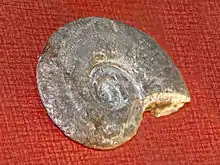| Ussuritidae Temporal range: Triassic | |
|---|---|
 | |
| Fossil of Monophyllites sphaerophyllus from Bosnia, on display at Galerie de paléontologie et d'anatomie comparée in Paris | |
| Scientific classification | |
| Domain: | Eukaryota |
| Kingdom: | Animalia |
| Phylum: | Mollusca |
| Class: | Cephalopoda |
| Subclass: | †Ammonoidea |
| Order: | †Ammonitida |
| Suborder: | †Phylloceratina |
| Family: | †Ussuritidae Hyatt, 1900 |
Ussuritidae are ancestral, Triassic, Phylloceratina characterized by generally smooth, discoidal, evolute shells with rounded venters and little or no ornamentation and by sutures with primitive monophyllitic saddles with a single terminal branch or leaflet.[1]
The Ussuritidae are most likely derived from the Dieneroceratidae[1] and give rise to the Discophyllitidae. Seven genera are included:
- Ussurites
- Palaeophyllites
- Monophyllites
- Majsvarites
- Leiophyllites
- Eopsiloceras
- Eophyllites
Genera are distinguished on the basis of shell morphology and characteristics of the suture.[1]
Ussuritidae are also known as the Monophyllitidae, a junior synonym. Palaeophyllitidae, for Palaeophyllites, is sometimes found in the literature.[2]
References
- 1 2 3 Treatise on Invertebrate Paleontology Part L Mollusca 4, Ammonoidea
- ↑ Paleobiology Database
This article is issued from Wikipedia. The text is licensed under Creative Commons - Attribution - Sharealike. Additional terms may apply for the media files.